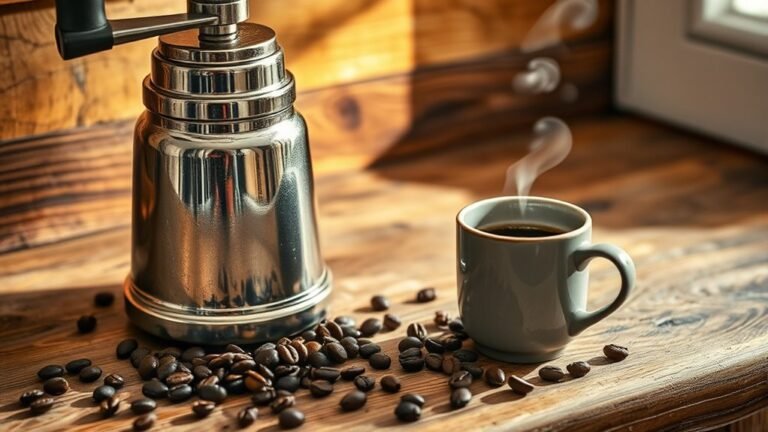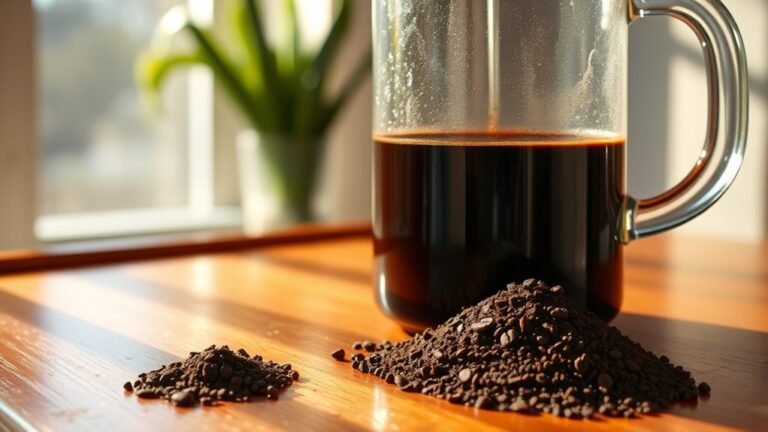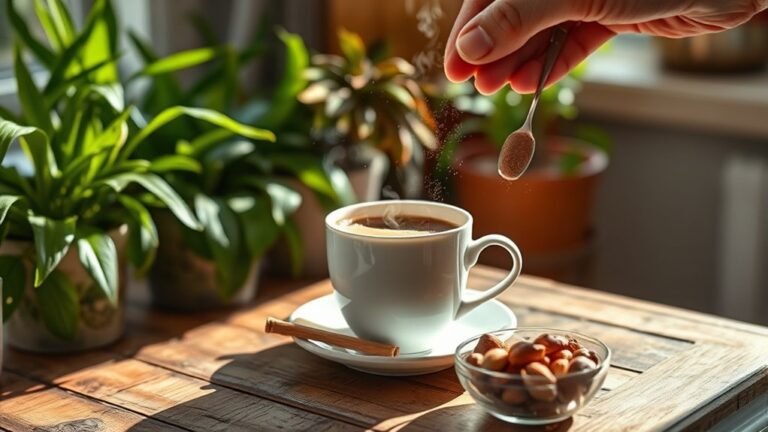How to Calibrate Your Coffee Grinder
To calibrate your coffee grinder, start by thoroughly cleaning it to remove old grounds and guarantee burrs are aligned for even spacing. Set the grinder to a mid-range setting, grind a small batch, and check the consistency. Brew a test shot or pour-over, observe extraction time, and adjust the grind size incrementally to balance flavor. Regular maintenance and slight tweaks help keep your grind ideal. Keep exploring these steps to access the full potential of your coffee beans.
Understanding Grind Size and Its Impact
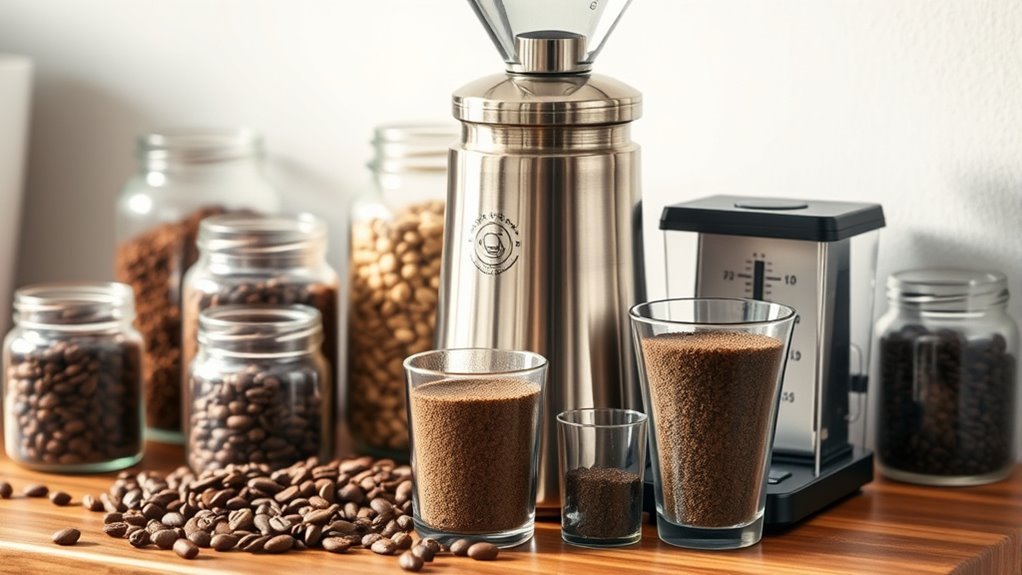
When you adjust your coffee grinder, understanding grind size is vital because it directly affects the flavor and extraction of your coffee. The grind size controls how quickly water passes through the coffee grounds, influencing grind extraction. Too coarse, and water rushes through, resulting in under-extracted coffee with weak flavor. Too fine, and extraction drags, often causing bitterness. By dialing in the right grind size, you reveal a balanced flavor profile that highlights the beans’ unique characteristics. This control lets you tailor your brew to your taste, granting you the freedom to experiment and perfect your coffee. Mastering grind size means mastering flavor — a significant step toward enjoying a consistently satisfying cup every time you brew.
Preparing Your Grinder for Calibration
Before you start calibrating your coffee grinder, there are a few essential steps you need to take to prepare it properly. Proper preparation guarantees your calibration is accurate and your grind quality consistent.
- Clean your grinder thoroughly: Remove all residual coffee grounds to minimize grind retention, which can skew your results.
- Check for any mechanical issues: Regular grinder maintenance, like inspecting burrs for wear or misalignment, sets a solid foundation.
- Reset your grinder settings: Bring your grinder back to a known baseline to avoid confusion during calibration.
Step-by-Step Calibration Process
Although calibrating your coffee grinder might seem technical, following a clear, step-by-step process will make it manageable and effective. Start by ensuring your grinder is clean and free from old grounds to minimize grind retention. Check and adjust the burr alignment carefully to avoid uneven particle sizes. Next, set your grinder to a mid-range setting as a baseline. Finally, grind a small amount and inspect the output for consistency.
| Step | Action |
|---|---|
| 1. Clean & Inspect | Remove old grounds, check burrs |
| 2. Align Burrs | Adjust burrs for even spacing |
| 3. Set & Test Grind | Choose mid-range, grind a sample |
This approach gives you control and precision, empowering your brewing freedom.
Testing and Adjusting Grind Consistency
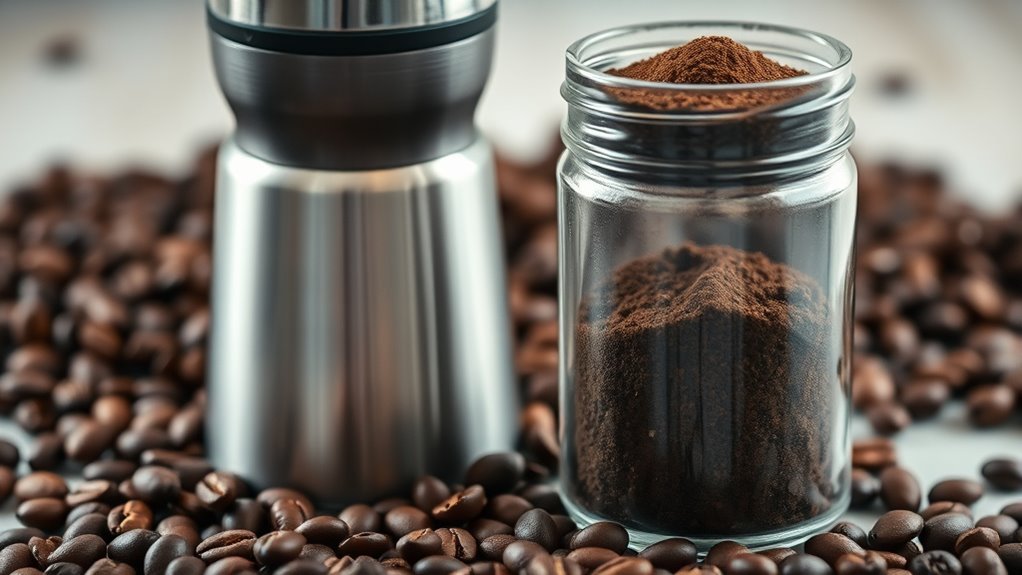
Anyone aiming for the perfect cup knows that testing and adjusting your grind consistency is essential. Achieving grind uniformity directly impacts extraction optimization, ensuring balanced flavor and aroma. To test and refine your grind, follow these steps:
Testing and adjusting grind consistency is key to perfecting extraction and unlocking balanced coffee flavors.
- Brew a small espresso or pour-over using your current grind setting.
- Observe the shot time or brew duration; too fast or slow indicates inconsistent grind size.
- Adjust your grinder incrementally, then re-test to dial in the ideal particle distribution.
Tips for Maintaining Optimal Grind Settings
Since grind settings can shift subtly over time, keeping them consistent requires regular attention and care. To maintain ideal grind settings, focus on minimizing grind retention and performing routine burr maintenance. Clean your grinder regularly to prevent old grounds from altering flavor and clogging burrs. Adjust settings incrementally and test frequently to find your perfect balance.
| Task | Frequency | Purpose |
|---|---|---|
| Burr cleaning | Weekly | Reduce grind retention |
| Burr inspection | Monthly | Verify sharpness |
| Grind adjustment | As needed | Maintain consistency |
| Hopper cleaning | Biweekly | Prevent stale grounds |
| Calibration check | After cleaning | Confirm grind accuracy |
Following these tips helps you enjoy freedom in your coffee experience without unpredictable grind shifts.
Frequently Asked Questions
How Does Grind Size Affect Caffeine Extraction?
Grind size directly affects caffeine extraction by influencing grind consistency and extraction time. If your grind is too coarse, water passes through quickly, resulting in under-extraction and less caffeine. Too fine, and extraction time lengthens, potentially over-extracting bitterness and caffeine. You want a balanced grind size to guarantee consistent particle size, which helps control extraction time, giving you the freedom to craft a cup with the caffeine strength you enjoy.
Can I Use a Blade Grinder for Espresso?
Imagine pulling a shot for a friend, only to get bitter, uneven espresso because your blade grinder freaked out on consistency. While you can use a blade grinder for espresso, it often lacks the grind consistency essential for top espresso quality. Burr grinders are better, giving you precise control to access rich flavors. If you value freedom and great espresso, investing in a burr grinder will really elevate your coffee game.
What’S the Difference Between Burr and Blade Grinders?
You’ll notice burr grinders crush beans between two abrasive surfaces, giving you consistent grind size and better flavor extraction—these are the burr grinder benefits. Blade grinders, on the other hand, chop beans unevenly with a spinning blade, leading to blade grinder drawbacks like inconsistent grind and bitterness. If you want more control and a smoother cup, burr grinders are the way to go, especially if you value freedom in your coffee experience.
How Often Should I Replace Grinder Burrs?
You should replace your grinder burrs regularly, monitor burr lifespan, and prioritize grinder maintenance to keep your coffee fresh and flavorful. Typically, burrs last between 500 to 1,000 pounds of coffee, or about 6 to 12 months with daily use. If your grind becomes inconsistent or brewing takes longer, it’s time to swap them out. Staying on top of this guarantees you enjoy consistent quality without sacrificing your freedom to experiment.
Does Grind Size Impact Coffee Flavor Profiles?
Yes, grind size definitely impacts flavor intensity and overall coffee flavor profiles. When you adjust your grind, you’re controlling how quickly water extracts flavors during brewing—finer grinds usually boost intensity and suit espresso, while coarser grinds mellow flavors and work well for methods like French press. By experimenting with grind size, you gain freedom to tailor your brew method and enjoy a cup that matches your unique taste preferences perfectly.




